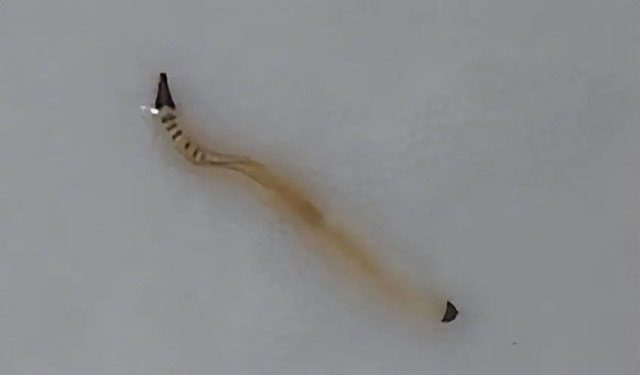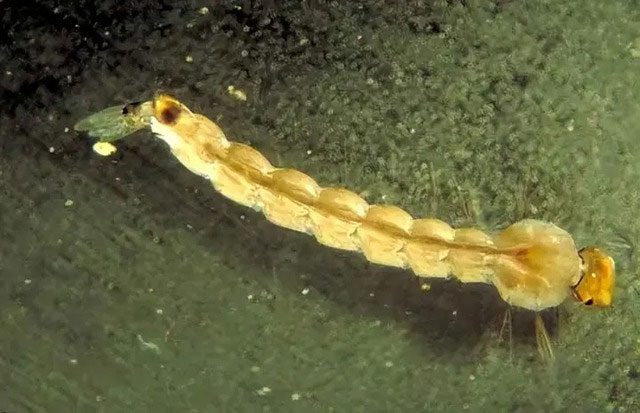In this experiment, scientists released 600 mosquito larvae into highly concentrated saltwater—an environment where virtually all living organisms cannot survive. However, these resilient mosquito larvae successfully adapted and quickly developed into fully grown adult mosquitoes.
Why Do Mosquito Larvae Survive in Salty Water: Adaptive Gene Mutation
To understand the survival of mosquito larvae, we need to consider their natural habitats. Typically, mosquito larvae thrive in freshwater environments such as rivers, lakes, and other bodies of water, as they require water to complete their growth and development. However, some mosquito larvae can survive in saltwater. These mosquito larvae possess a specific gene mutation that enables them to adapt to high salinity environments.
So, why are these mosquito larvae capable of surviving in high salinity environments? Scientists have discovered that this is linked to their gene mutations. Normal mosquito larvae lose water in high salinity environments, leading to death. However, these larvae have adapted to salty environments and possess a special gene that allows them to survive in saltwater. This gene mutation enables them to maintain higher water content in their bodies and counteract the effects of salt, improving their survival rate in saline conditions.

Mosquito larvae with special gene mutations that can live in saltwater.
How did this gene mutation arise? Researchers found that it is related to the process of natural selection. When high salinity water exists in an environment, normal mosquito larvae cannot survive, and only those with adaptive gene mutations can endure. These larvae, adapted to saline environments, can successfully develop into mature adults and reproduce the next generation. Over time, the adaptive gene mutations gradually spread throughout the mosquito population, allowing more mosquito larvae to adapt to high salinity environments.
What does this research signify for our lives? Firstly, it enhances our understanding of how mosquitoes survive. Mosquitoes are resilient creatures capable of adapting to various environments and have a high survival rate. Secondly, this research provides us with a new perspective on controlling mosquito-borne diseases. By gaining a deeper understanding of the survival mechanisms of mosquitoes, we can better explore effective methods for controlling mosquito reproduction and transmission.

Adaptive gene mutations gradually spread throughout the mosquito population as a result of natural selection.
Reasons Mosquito Larvae Survive in Salty Water: Unique Physiological Structures
The ability of mosquito larvae to survive in saltwater is primarily due to their unique physiological structures. First, the outer fluid of mosquito larvae contains a substance known as glycerol. Glycerol is an organic compound with moisture-retaining and antifreeze properties that help prevent dehydration and cellular damage due to freezing temperatures. When mosquito larvae are exposed to saltwater, glycerol quickly dissolves in the water, forming a protective membrane that covers the outer surface of the cells to maintain internal stability. This allows mosquito larvae to maintain normal metabolic activity and live functions in salty water.
The exoskeleton structure of mosquito larvae is also a significant reason for their survival in saltwater. The exoskeleton of mosquito larvae consists of a hard chitinous layer, similar to a shell. This hard outer layer effectively prevents salt from penetrating the mosquito larvae, thereby reducing the harmful effects of saltwater on the cells. Additionally, the exoskeleton of mosquito larvae is highly flexible and can adapt to pressure and deformation in saltwater, further protecting cellular integrity.

The exoskeleton of mosquito larvae includes a hard chitinous layer, similar to a shell.
Mosquito larvae also adapt to saline environments by regulating osmotic pressure within their cells. When mosquito larvae are in saltwater, due to the high osmotic pressure of the saltwater, intracellular dehydration occurs, and the osmotic pressure of the extracellular fluid increases. To balance the osmotic pressure difference inside and outside the cells, mosquito larvae maintain stable osmotic pressure within the cells by transporting ions and adjusting solute concentrations. This mechanism ensures the balance of substances inside and outside the cells, maintaining normal physiological functions of mosquito larvae.
Assistance from Symbiotic Bacteria
Recent studies have found that a crucial reason mosquito larvae can survive in saltwater is thanks to the help of symbiotic microorganisms. Symbiotic microorganisms are those that live alongside a host organism and have a positive impact on it. Inside mosquito larvae, there is a special type of symbiotic microorganism known as salt-accepting symbiotic bacteria.
This salt-tolerant symbiotic bacteria live in the intestines of mosquito larvae. In saltwater, the salt that mosquito larvae ingest enters their digestive system, where the symbiotic organisms accept and utilize the salt. These symbiotic bacteria convert the salt into compounds that the mosquito larvae can use. In this way, the salt-accepting symbiotic bacteria help mosquito larvae overcome the adverse effects of the saltwater environment and ensure their survival.

Symbiotic bacteria help mosquito larvae survive in saltwater environments.
In addition to assisting in salt conversion, salt-accepting symbiotic bacteria can produce certain special substances that are also crucial for the survival of mosquito larvae. For example, they can generate antioxidants that help mitigate the harmful effects of saltwater on the mosquito larvae’s body. Furthermore, these symbiotic bacteria also influence the immune system of mosquitoes, enhancing their resistance and aiding them in better coping with the challenges of the salty environment.
However, researchers have also discovered that not all mosquito larvae possess the presence of salt-accepting symbiotic species. This phenomenon may be related to environmental and genetic factors in mosquito larvae. Researchers hope that by deeply studying the relationship between salt-tolerant symbiotic bacteria and mosquito larvae, they can provide new ideas and methods for controlling mosquito populations and disease transmission.




















































